Ridley Pearson - The Art of Deception
Здесь есть возможность читать онлайн «Ridley Pearson - The Art of Deception» весь текст электронной книги совершенно бесплатно (целиком полную версию без сокращений). В некоторых случаях можно слушать аудио, скачать через торрент в формате fb2 и присутствует краткое содержание. Жанр: Триллер, на английском языке. Описание произведения, (предисловие) а так же отзывы посетителей доступны на портале библиотеки ЛибКат.
- Название:The Art of Deception
- Автор:
- Жанр:
- Год:неизвестен
- ISBN:нет данных
- Рейтинг книги:3 / 5. Голосов: 1
-
Избранное:Добавить в избранное
- Отзывы:
-
Ваша оценка:
- 60
- 1
- 2
- 3
- 4
- 5
The Art of Deception: краткое содержание, описание и аннотация
Предлагаем к чтению аннотацию, описание, краткое содержание или предисловие (зависит от того, что написал сам автор книги «The Art of Deception»). Если вы не нашли необходимую информацию о книге — напишите в комментариях, мы постараемся отыскать её.
The Art of Deception — читать онлайн бесплатно полную книгу (весь текст) целиком
Ниже представлен текст книги, разбитый по страницам. Система сохранения места последней прочитанной страницы, позволяет с удобством читать онлайн бесплатно книгу «The Art of Deception», без необходимости каждый раз заново искать на чём Вы остановились. Поставьте закладку, и сможете в любой момент перейти на страницу, на которой закончили чтение.
Интервал:
Закладка:
“I won’t bother you with the Home and Garden tour, but I’m telling you: The prints aren’t his. It was pure oxygen in those tanks as you suspected. It’s your job to find out where he stole them.”
“Could they be one-half of an oxyacetylene rig?” Boldt asked.
“Welding? Absolutely.”
“As in construction sites?”
“Are you going somewhere with this?” Lofgrin asked.
“Our hotel peeper … the construction site.”
Lofgrin nodded slowly. “Ah-so,” he said.
Boldt’s scribbling was for real, as he made a note to check all recent downtown construction sites for reports of stolen oxygen. When things began to come together on a case, an investigator could feel the momentum shift his way. It brought on an almost childish giddiness sometimes-a visceral high that was one of those things you lived for, the way a marathon runner knew when he’d hit his stride and the training was finally paying off. The Big Mo was in this lab with him, and Boldt took it for a ride.
“Go,” he encouraged.
“Hairs and fibers workup,” Lofgrin said, aiming his distorted eyes toward Boldt. “I caution that this is all prelim, but we did lift seventeen black hairs from a five-gallon tub of wastewater, presumably where this guy washed up. Head hairs. We also ran all the clothing we found into the scrape room and collected a sizeable amount of fiber evidence. Initial examination of the black head hairs was conducted both macroscopically and mi-croscopically. Cell structure confirms they’re from an Asian. We picked up chromosomes on the sheath material from one sample that confirms it’s male hair. This particular Asian male had smoked pot within the last month. That shouldn’t be too hard to confirm for your Mr. Chen, should it?” Boldt’s pen went to work. “We’ve asked Dixie for comparison head hair samples from Chen. If we get a good probability, and I think we will, then we’ll perform STR-short tandem repeat-DNA analysis.
It’s quick and reliable, and cheaper than the old RFPL. I could have something for you by tomorrow or the next day.”
Boldt mentally assembled the pieces. In all likelihood Chen had had physical contact with whomever had been in residence at the underground hideout. This, in turn, implied the obvious.
He asked, “Blood evidence?”
“You’re a pushy son of a bitch. You know that? Phenol-phthalein test was positive. And check out the Luminol.” He handed Boldt a color photo that showed blobs of blue where the Luminol had reacted with any residual blood in the converted storage room. A special fluorescent light was used to highlight the Luminol. The pattern suggested footprints.
“These were developed by the doorway?” Boldt asked.
“We fluoresced the whole room, but yes, this photo was shot near the door. The blood had been washed with soap and water or maybe something a little stronger.” He presented another photo, also revealing Luminol stains on the lip of a container.
“Again, this is the same wastewater plastic tub.”
Boldt said, “He washed his hands of the blood and some hair came off in the process.”
Lofgrin nodded.
“If you were a woman, I’d kiss you.”
“I’d file for harassment.” Lofgrin handed Boldt yet another photo, this time showing a pair of workman’s coveralls, also photographed in the dark under the illumination of fluorescent black light. The discoloring indicated blood splatter, like a volley of cascading tears.
“Oh, God,” Boldt muttered.
“Yes. Exactly. Jackson Pollock this isn’t.” Before Boldt could ask, Lofgrin answered. “This was also washed, but in a heavy detergent. No way to type it, no chance for DNA. Could be the guy butchered an elk.”
“Or a couple missing women,” Boldt said.
Lofgrin said, “He wears size ten-and-a-half shoes. About six feet tall. Hair color brown, but it’s dyed-from a sandy blond.
He’s on a strong dose of doxycycline.”
Lofgrin was probably not describing Ferrell Walker, Boldt realized. Dyed hair? Nathan Prair, perhaps-although that also felt like a stretch.
“Are you telling me we found a ’script bottle down there?
Are you holding out on me, Bernie? Do you happen to have a name from that prescription?”
“No prescription, no bottle, either. His hair, the dyed hair, the predominant hair sample found down there in that room,”
Lofgrin answered, “revealed the doxycycline. You are what you ingest. Most of it goes into your hair.”
“He’s fighting an infection,” Boldt said. The use of hair coloring bothered the detective in him. Women, sure. But a man using hair coloring suggested more than vanity to a cop-if the occupant of that room had changed his looks, the possibility existed that he’d done so in an effort to outrun a criminal record.
Boldt’s pen wrote down: Ex-con? Escapee?
“Are we done here?” Boldt asked, anxious to work the evidence.
“What do you think?” It was Lofgrin’s way to hold some cherry for the end of such prelims. The hair coloring and doxycycline had seemed the punctuation mark to Boldt-the exclamation point-but the lack of Lofgrin’s proud-as-a-peacock, I’m-smarter-than-you superior attitude had left him thinking there might be more.
“Out in the hallways as we were looking for his escape route we came across some recent bus ticket stubs.”
“I entered through the bus tunnel emergency route, Bernie.
We already know he had access.” Boldt added, “And you knew that, too, because it’s how your guys got in there, so what’s going on?” Lofgrin appreciated being challenged, or Boldt wouldn’t have been so aggressive. Friendships within the department were both a curse and a blessing.
Lofgrin dug around on the lab bench and produced an evidence bag that contained a rectangular piece of paper-a receipt, or stub. “ATM receipt. SeaTel.” Boldt knew that SeaTel was the bank on the corner, the basement of which he’d toured with the maintenance man. “You’re interested in the date.”
Boldt snatched the bag from Lofgrin, his chest tight. He pressed the plastic of the bag against the receipt, trying to read the date. He fumbled and dropped the bag. Lofgrin spoke as Boldt collected the bag off the floor. “One of my guys-Michael Yei-his sister’s a teller at SeaTel over in Capitol Hill. The account comes back a sixty-year-old woman named Veronica Shepherd. I doubt seriously Ms. Shepherd is living below Third Avenue.”
Boldt had the bag in hand again. He pressed, and the date printed on the receipt came into focus. It was a date emblazoned in Boldt’s memory, the date Susan Hebringer had gone missing.
Boldt experienced both a pang of hurt and one of exhilaration simultaneously.
“Cash machines,” Boldt said hoarsely, his voice choked with emotion. He’d found the connection between the tourists who’d been peeped and the two missing women. “The common de-nominator is cash machines.”
He was out the door before he had a chance to witness Lofgrin’s self-satisfied grin.
Boldt double-parked the department-issue Crown Vic, its emergency flashers going, on the steep incline outside SeaTel. He approached the corner entrance to the bank at a run, but stopped abruptly at sight of the small lighted sign: ATM. Any investigator worth his salt questioned himself when the facts became known. You wondered why and how something so obvious now had seemed so insignificant then, how the brain could overlook something so important, so glaring.
It was a small glassed-in room-a glorified booth-that fronted Columbia Street and contained two ATM machines side by side, a wall clock, and a small blue shelf with pens attached to chains. Mounted to the doorjamb, an electronic credit card reader provided restricted access for the sake of security, admitting only legitimate cardholders.
Читать дальшеИнтервал:
Закладка:
Похожие книги на «The Art of Deception»
Представляем Вашему вниманию похожие книги на «The Art of Deception» списком для выбора. Мы отобрали схожую по названию и смыслу литературу в надежде предоставить читателям больше вариантов отыскать новые, интересные, ещё непрочитанные произведения.
Обсуждение, отзывы о книге «The Art of Deception» и просто собственные мнения читателей. Оставьте ваши комментарии, напишите, что Вы думаете о произведении, его смысле или главных героях. Укажите что конкретно понравилось, а что нет, и почему Вы так считаете.












